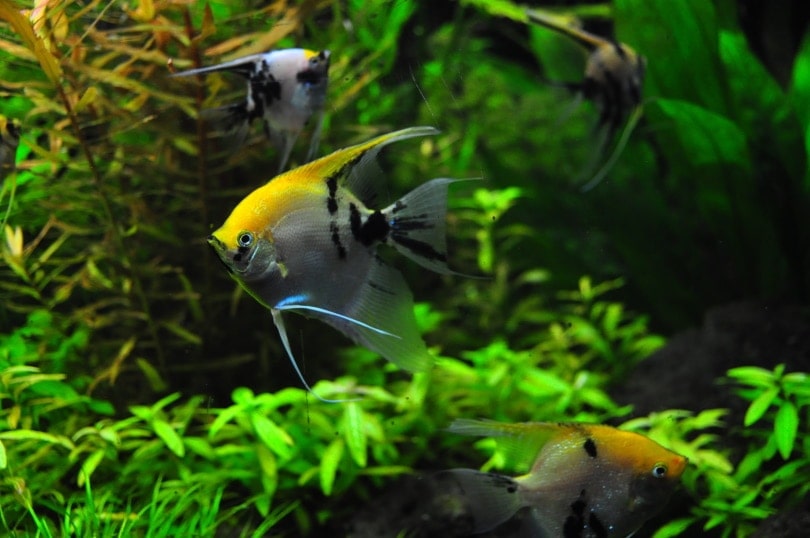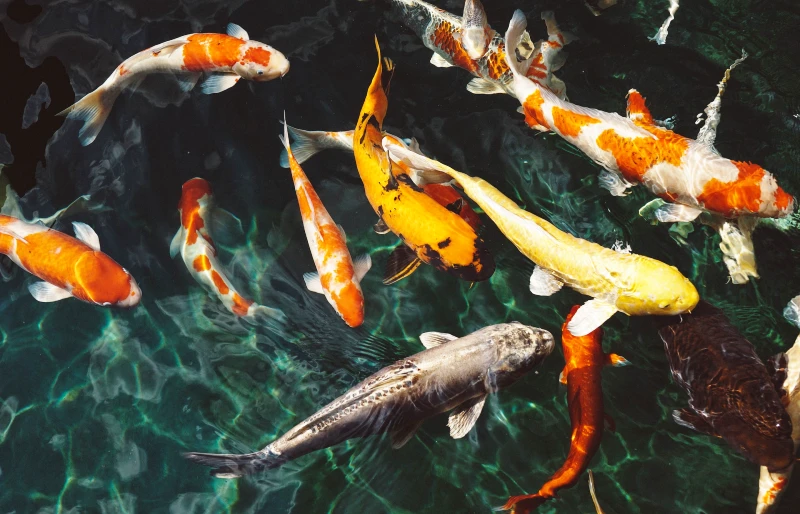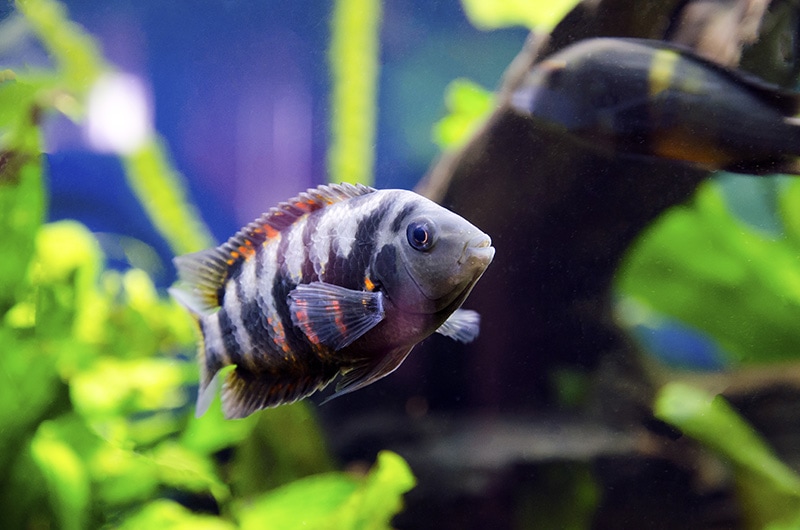9 Great Tank Mates for Peacock Eels (With Pictures)

Updated on

Click to Skip Ahead
Getting an eel might not top your list of species to add to a fish tank. However, they are fascinating creatures. Despite its looks, the Peacock Eel is a peaceful animal that can get along with many popular aquarium fish as long as they are big enough and fast enough to evade this potential predator.

The 9 Great Tank Mates for Peacock Eels
1. Discus (Symphysodon discus)

| Size | 6–10 inches |
| Diet | Carnivore |
| Minimum tank size | 50 gallons |
| Care Level | High |
| Temperament | Peaceful |
The Discus is a peaceful fish that keeps to itself, as indicated by its gentle nature. It gets to be a decent size, which puts it out of the range where the Peacock Eel would eat. This species also does better in a larger tank, which gives it extra room to avoid crossing paths with the eel. The Discus requires more care and attention to water conditions, which benefit the eel in the process.
2. Rainbow Kribensis (Pelvicachromis pulcher)

| Size | Up to 5 inches |
| Diet | Omnivore |
| Minimum tank size | 20 gallons |
| Care Level | Easy |
| Temperament | Peaceful |
The Rainbow Kribensis is an African, cave-spawning species. This fish is best kept in pairs. It is peaceful for the most part, except during breeding. Otherwise, it is an easy-going fish that does well as part of a community tank. It gets along with most fish as long as they are bigger. It is an omnivore but enjoys more meat protein in its diet.
3. Forktailed Rainbowfish (Pseudomugil furcatus)

| Size | Up to 2 inches |
| Diet | Omnivore |
| Minimum tank size | 30 gallons |
| Care Level | Easy |
| Temperament | Peaceful |
The Forktailed Rainbowfish lives in a similar environment as the Peacock Eel. It is a striking fish that does best in groups. It prefers an aquarium that has many plants and décor to provide hiding places. It is a fast and active fish, in contrast to the slower pace of the Peacock Eel. This fish shows up well if you use a neutral-colored substrate to highlight its coloration.
4. Swordtails (Xiphophorus hellerii)

| Size | 5 to 6 inches |
| Diet | Omnivore |
| Minimum tank size | 20 gallons |
| Care Level | Easy |
| Temperament | Peaceful |
The name of the Swordtail refers to its long caudal fin. It’s a popular aquarium fish because of its agreeable nature and hardiness. It’s not a picky eater, which is another advantage. It is a gentle fish that does best with species of a similar temperament. Like many other species, it is often territorial during breeding.
5. Kissing Gourami (Helostoma temminkii)

| Size | Up to 12 inches |
| Diet | Omnivore |
| Minimum tank size | 40 gallons |
| Care Level | Moderate |
| Temperament | Semi-aggressive |
Kissing Gouramis are a favorite among enthusiasts for their cute looks and behavior. They are cousins to the popular Betta Fish because of their ability to breathe atmospheric oxygen. The fish has a pearly color that appears iridescent under UV light. It fares best with species of a similar size because of its semi-aggressive nature.
6. Hatchetfish (Carnegiella strigata)

| Size | Up to 2 inches |
| Diet | Insect larvae |
| Minimum tank size | 30 gallons |
| Care Level | Moderate |
| Temperament | Schooling |
The Hatchetfish stands out for its unusual body shape that resembles its name. Despite its smaller size, it won’t have much to do with the Peacock Eel as a top-dwelling fish. They can also jump if the need arises. They do best in small groups, where they will provide the necessary protection. This species is most comfortable under vegetation that provides it with cover.
7. Angelfish (Pterophyllum scalare)

| Size | 8–10 inches |
| Diet | Carnivore |
| Minimum tank size | 30 gallons |
| Care Level | Moderate |
| Temperament | Peaceful |
Few fish have such a devoted following as the Angelfish. It practically glides through the water. It is a docile fish, despite its carnivorous appetite. It is also a slow-moving fish, which makes it vulnerable to communities with faster species. Like the Peacock Eel, it takes life at its own pace, which makes it an excellent tank mate.
8. Silver Dollars (Metynnis argenteus)

| Size | Up to 8 inches |
| Diet | Herbivore |
| Minimum tank size | 40 gallons |
| Care Level | Moderate |
| Temperament | Peaceful |
The Silver Dollar’s appearance is deceptive because it resembles more aggressive species, such as the Pacu and the Piranha. It is a long-lived species that can live for 10 or more years. It hangs out in the middle of the tank, which poses little conflict with the Peacock Eel. It is also a schooling fish that does best with other members of its species.
9. Blood Parrot Cichlids (Amphilophus citrinellus x Paraneetroplus synspilus)

| Size | 7 to 10 inches |
| Diet | Omnivore |
| Minimum tank size | 30 gallons |
| Care Level | Moderate |
| Temperament | Peaceful |
The Blood Parrot Cichlid is a hybrid species, making it somewhat controversial among certain enthusiasts. It does well with other schooling fish of a similar size, although hiding places are necessary. It will hang out in the middle of the tank and occasionally cross paths with the Peacock Eel on the bottom.
What Makes a Good Tank Mate for Peacock Eel?
The Peacock Eel is an animal that prefers to be left alone and will do the same with the right tank mates. The eel is docile enough. The danger rests with tempting it to devour other fish that are too small or slow. The area where other fish prefer is another vital characteristic. Top and mid-dwelling species won’t have many conflicts with the Peacock Eel.
Where Do Peacock Eel Prefer to Live in the Aquarium?
The Peacock Eel prefers the bottom part of the tank, although it can move into the upper reaches if necessary. It is a nocturnal creature that you may not see too active during the day. It often burrows into the substrate because of its shy nature.
Water Parameters
The Peacock Eel prefers a warmer tank of 73–82℉, which you can keep stable with a heater that is suitable to the tank size. We recommend monitoring the temperature with a thermometer to make sure it doesn’t fluctuate too much. Neutral pH is best for the eels. Good water quality with 0 ppm for ammonia, nitrites, and nitrates is ideal.
Size
A tank of at least 40 gallons will give the Peacock Eel enough room to roam and support future growth. It also means less maintenance and greater stability of the water conditions. We suggest giving careful thought to the placement of your aquarium, given the weight of a filled tank. Décor is essential for both the eel and its tank mates. A substrate of at least 4 inches will provide enough burrowing space.
Aggressive Behaviors
The primary aggressive behavior is predation. However, the animal is just acting on instinct to chase something smaller than it is. While it lives peacefully with other fish, you can’t say the same with other fish of its type. It is often quite territorial with other of its species. Keeping one in a tank is the best way to enjoy them.

The 4 Benefits of Having Tank Mates for Peacock Eel in Your Aquarium
1. An Interesting Addition to Your Tank
Even though it resembles a snake, the Peacock is not a reptile. Its similarity makes it a more interesting animal to watch.
2. Docile Tank Mates
The Peacock Eel’s appearance belies the fact that it is a friendly tank mate that will keep to itself for the most part. It isn’t fussy or overly sensitive.
3. A Challenging Addition
The Peacock Eel isn’t a beginner fish. Its care is moderate, with feeding it one of the more challenging aspects of it. Many pet owners appreciate the advanced level of care needed to keep it healthy.
4. Relatively Healthy
The Peacock Eel is a hardy species that can fare well if you provide it with the right living conditions. It is susceptible to few diseases. We recommend checking the water chemistry parameters at least every 2 weeks.
Conclusion
The Peacock Eel is an excellent way for enthusiasts to advance their knowledge of aquatic life with an animal that is relatively easy to care for and hardy. It’s a peaceful fish, which makes it easy to pair with other tank mates of a similar temperament. The main concern is the size of the other denizens in the tank. It helps if they are fast and occupy a different level in the aquarium.
The best prescription for success is a stable tank environment. It will reduce stress and help other tank mates survive in a community setting. Doing regular water changes and monitoring its quality will go a long way toward ensuring that everything is suitable for all the fish.
See Also:
Featured Image Credit: Schitikoff, Shutterstock











